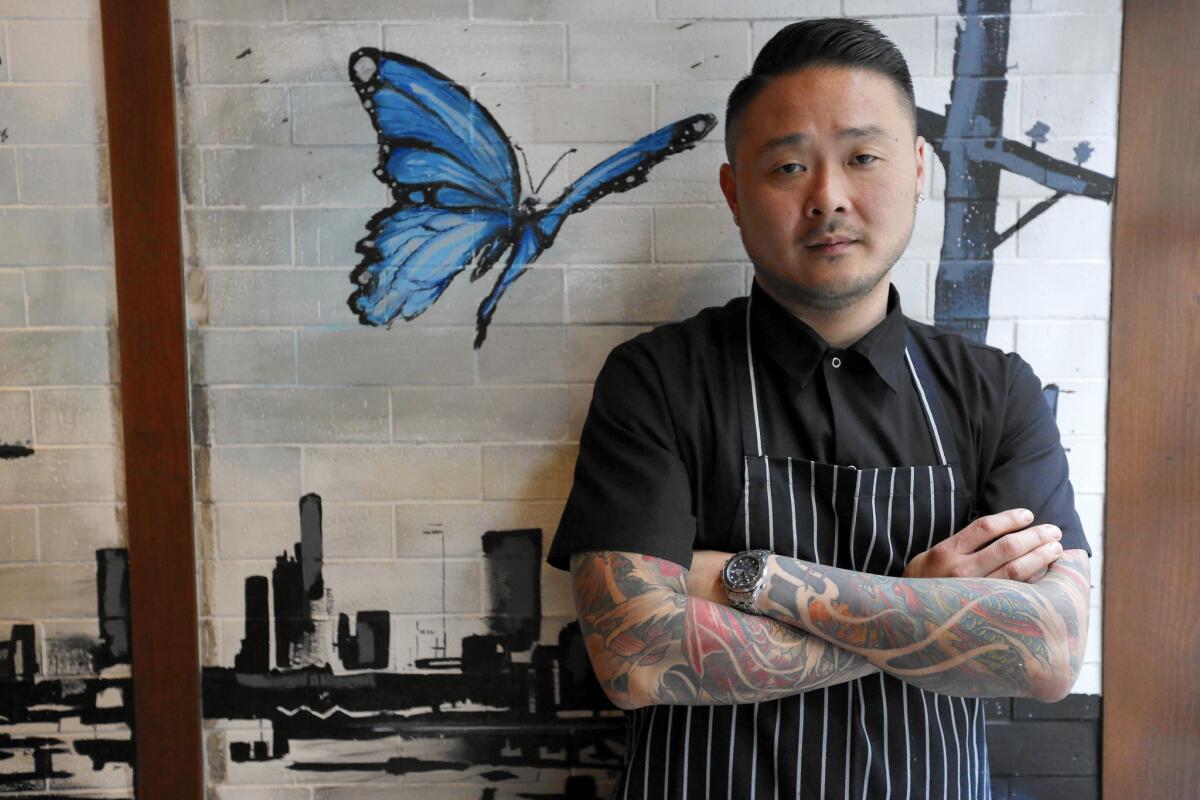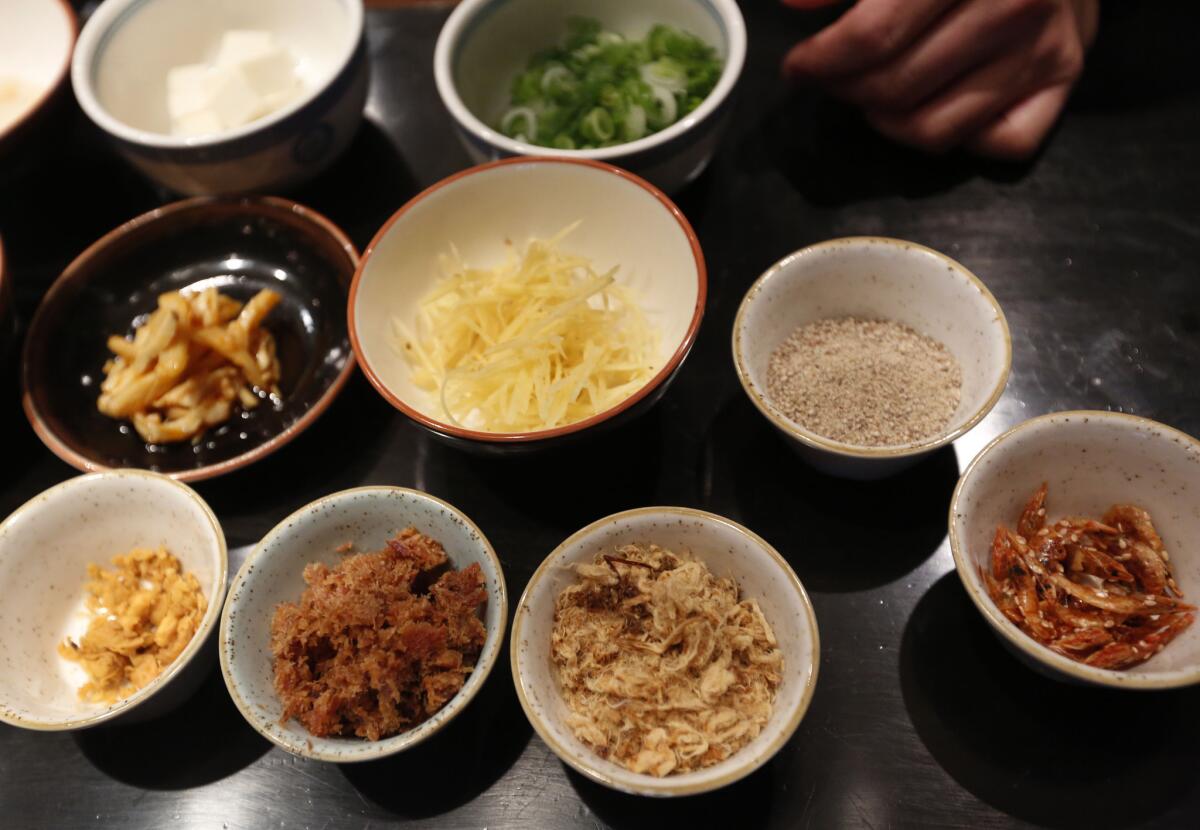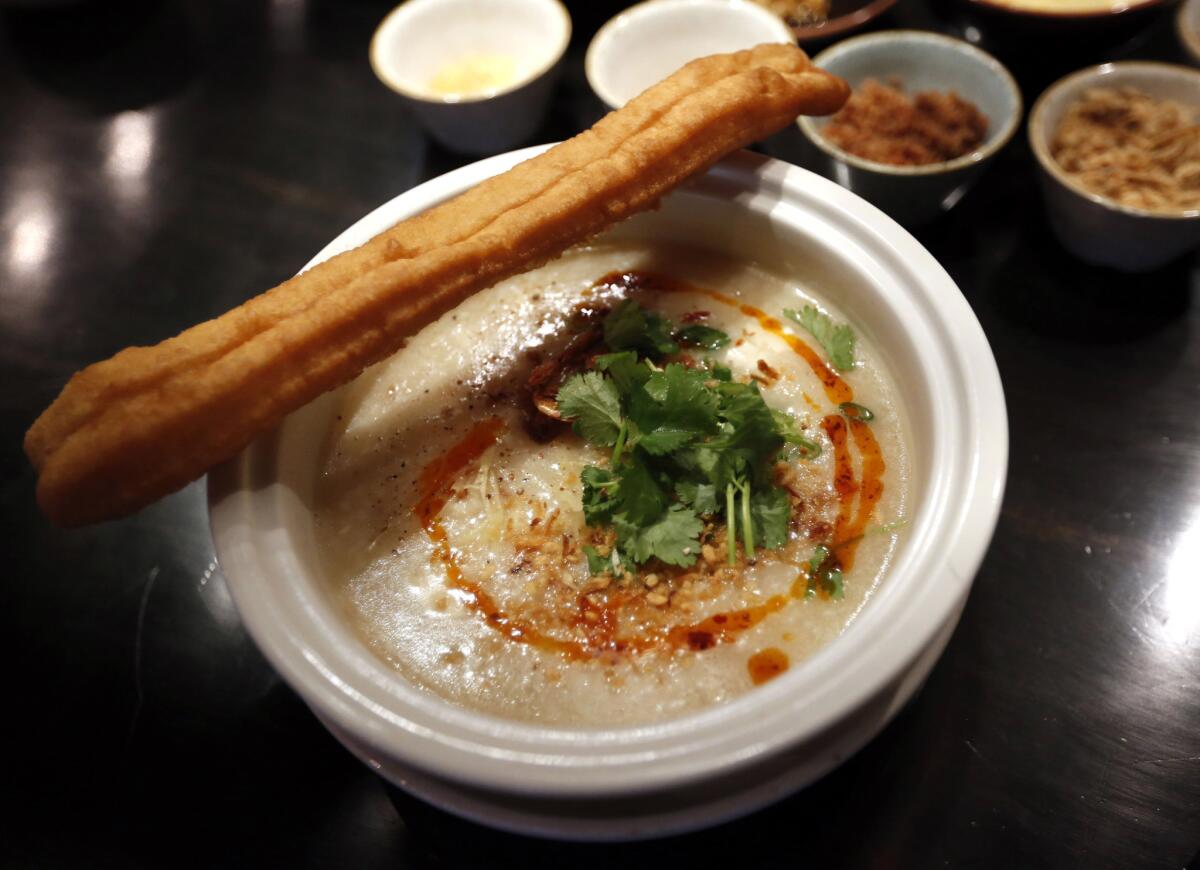Chef Tin Vuong of Little Sister shares tips for making congee

Congee isn’t so much a recipe as it is a state of mind. The simple rice porridge, popular by one name or another over most of Asia, is both comfort food and blank canvas, a delivery mechanism for warmth and solace and nutrition all at once. So when chef Tin Vuong opened his second Little Sister, the downtown Los Angeles version of his Manhattan Beach restaurant, and decided to serve breakfast along with his plates of lemon grass beef and salt cod fried rice, congee went on the menu.
It’s a dish Vuong grew up with in the San Gabriel Valley, where his grandmother would make bowls of it using leftover rice and adding whatever was on hand to the mix. “Dude, at my house, you had a pot of rice going all the time,” said Vuong on a recent morning at his new restaurant, where he had set up a hot plate behind the counter to demo a few iterations of the dish.
SIGN UP for Jonathan Gold’s Counter Intelligence dining newsletter >>
Vuong’s congee is cheffed up, stewed jasmine rice served with duck confit, with his house-made salted pork or with the glorious obsidian black tea eggs he preserves over a speeded-up yet week-long process — traditional tea eggs can take well over a month. But minus the accouterments, the congee is so simple that you don’t even need a recipe. Get a pot, heat some stock, add some cooked rice and cook until it’s done. There’s your recipe.

The chef grew up in Monterey Park, where his family moved in a circuitous route from Shanghai to Saigon to Los Angeles. His version of congee is thus Vietnamese and Cantonese, as he describes it, at once a flashback to his childhood and a form of restaurant economy.
“You can put anything in it you want,” Vuong says, as a sous-chef brings him little bowls filled with ingredients from the nearby kitchen. “I try and do the ones I know, the staples of the jook world,” he says, using the Cantonese word for the dish. “My variation of what it should be,” he says after a beat, pouring house-made chicken stock into a small pot set on the heat.
Vuong’s basic congee instructions require two main components — 1/2 cup of cooked jasmine rice, left over from service the day before; and 2 cups of the chicken stock the restaurant makes every day. At Little Sister, both are made with a bit of schmaltz, or chicken fat. Those making this at home can just use commercial broth. “When I’m lazy,” says the chef, “bouillon base works too.” You can even use plain water and maybe torque it up with a little soy sauce.
Another beautiful thing about congee? “It’s foolproof. If you usually overcook your rice, you’re perfect.”
Vuong likes to boil his rice, stirring the stock and the rice over high heat continuously (“I think the flavor comes out faster when it boils”), although you can turn it down and stir it less often if you want. Think of it like a basic form of risotto, the rice thickening the liquid as it cooks. Vuong also likes to add a bit of fresh ginger, some white pepper and a small pour of sesame oil to the congee as it thickens. And as with risotto, it’s best to use a wooden spoon — Vuong uses a bamboo dumpling stuffer. “It works like a stir stick,” he says, as a cloud of steam rises from his watched pot.
On the counter, there are little bowls of salted pork, cubes of soft tofu, salted cabbage, dried shrimp, fried garlic, threads of fresh ginger, chopped green onions, fresh cilantro, chile oil, sesame oil and finally a small bowl of raw scallops and shrimp assembled on the counter beside the pot. And though the chef makes these components himself — drying the shrimp, dehydrating and deep-frying the pork belly — he points out that you don’t have to. Just go to an Asian market and you’ll find most all of those things, in one form or another. And if you don’t have salted pork, he notes, “just add bacon.” Exactly.

Vuong keeps stirring, lifting up a bit of the cooking porridge to check the grains. “I’m looking for the blooming effect of the rice,” he says, noting that, rather like popcorn, grains of rice blister when they cook. When the rice has split open and its starch has thickened the mixture to resemble a stew rather than a soup, Vuong adds the raw seafood. He stirs for only a few minutes, then adds the tofu, cabbage and more ginger, and tastes it again.
“Everything is building flavors,” he says. “Americans tend to season too much — you can’t go backwards.” And with that, he ladles the congee into a bowl, adds small spoonfuls of salted pork, dried baby shrimp, green onions, fried shallots and garlic, cilantro and a bit more ginger. He drizzles some chile oil over the top, tosses on a bit more cilantro. And for the final touch, he places a fried Chinese doughnut over the bowl like a paddle across a canoe.
“If I served this at home, I’d chop it up,” Vuong says of the doughnut, noting that though he also makes those in-house, at home he’d just have gotten a bag of them from a nearby bánh mi shop. (You can also find them at many mom-and-pop Chinese restaurants, near the cash registers.)
“This is breakfast or brunch or late-night food,” says Vuong, expertly deconstructing another crisp doughnut and dropping it into the next bowl of congee, while noting that his grandmother would portion cooked rice into zip-lock bags and freeze it for when it was needed. “It’s definitely drunk food.”
ALSO:
Late-night dining survival guide: 11 places to eat after last call
Where to get Korean-style shabu shabu in K-Town, with plenty of cold beer
Jonathan Gold review: At Leona, the roast dumpling squash makes a statement
More to Read
Eat your way across L.A.
Get our weekly Tasting Notes newsletter for reviews, news and more.
You may occasionally receive promotional content from the Los Angeles Times.







